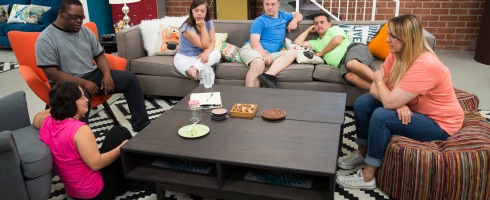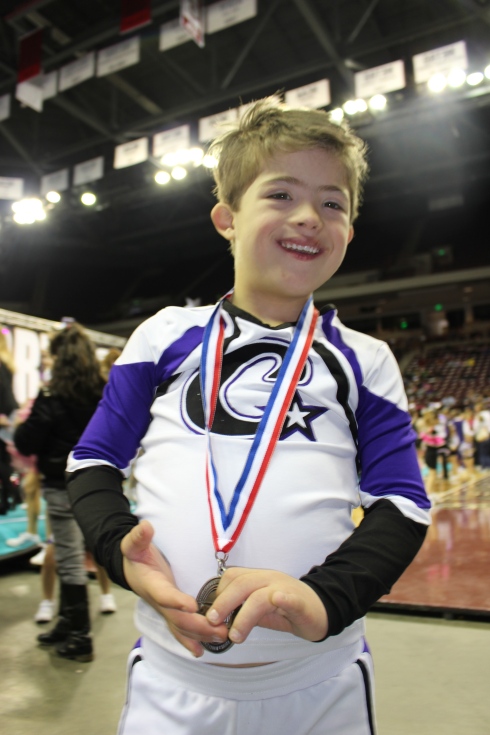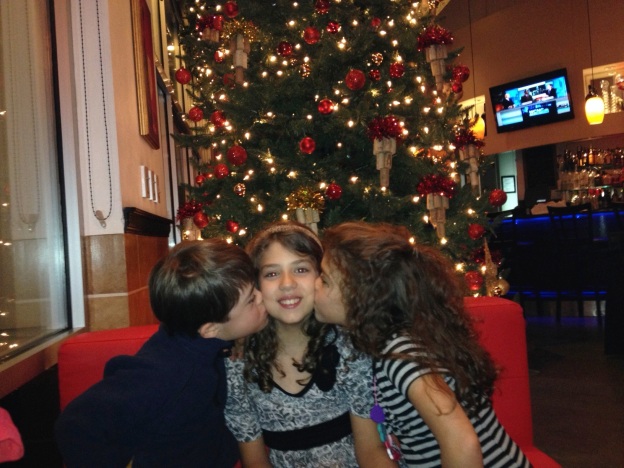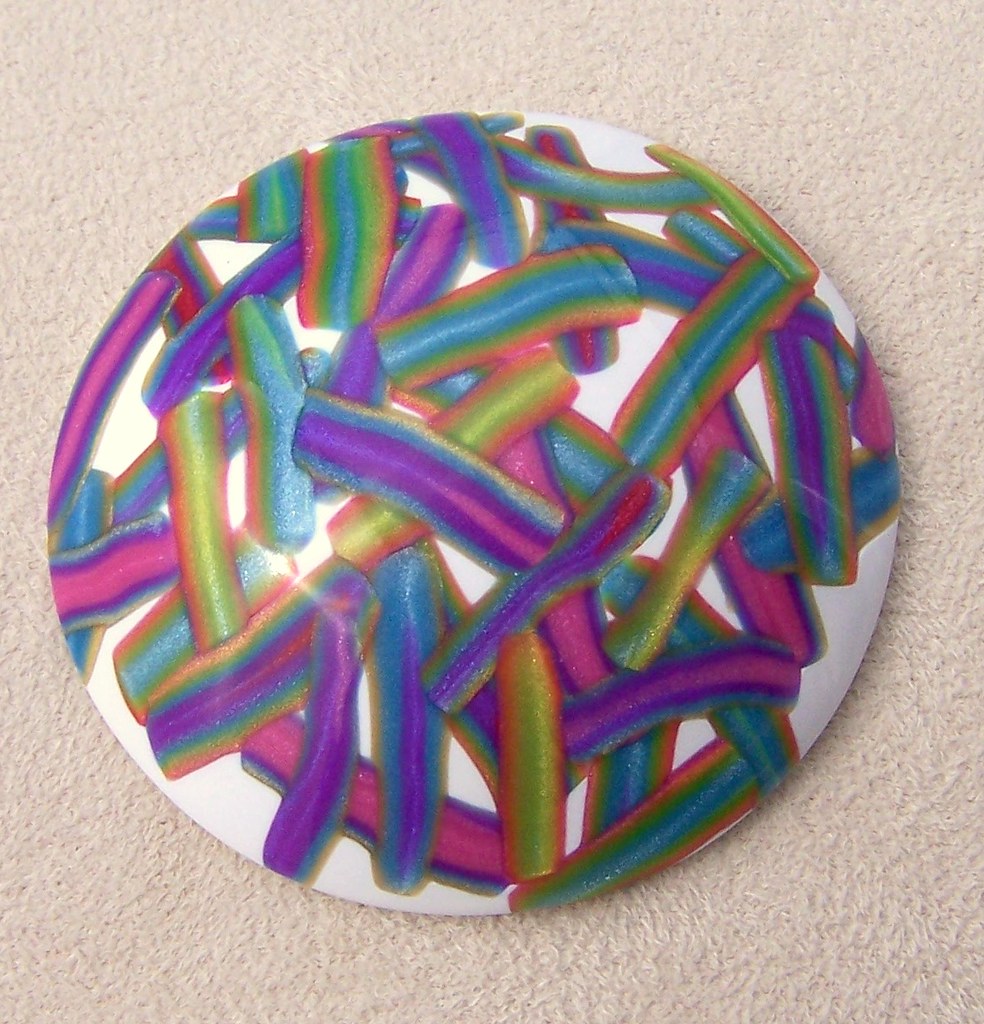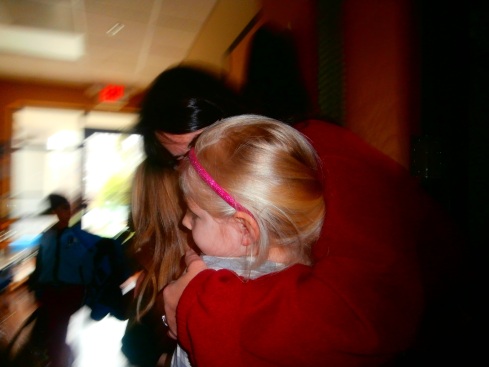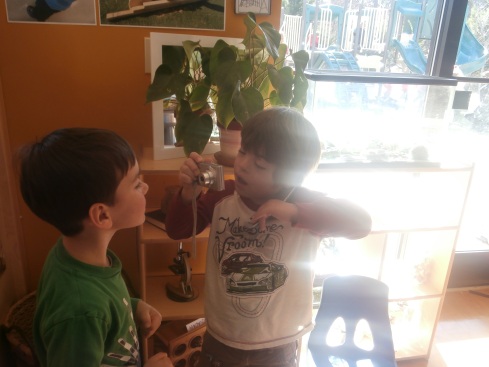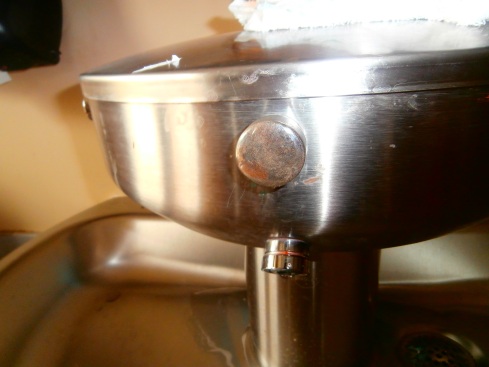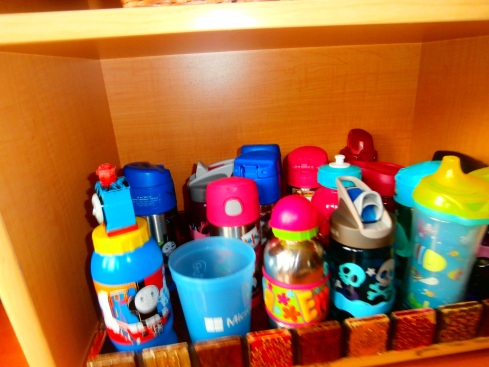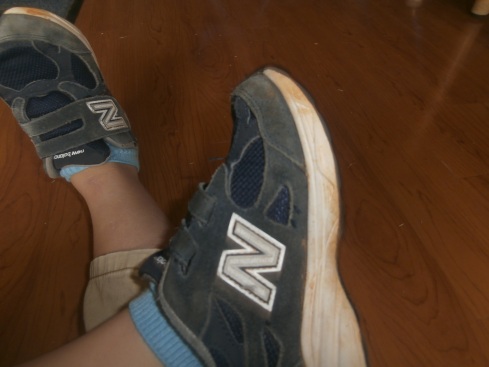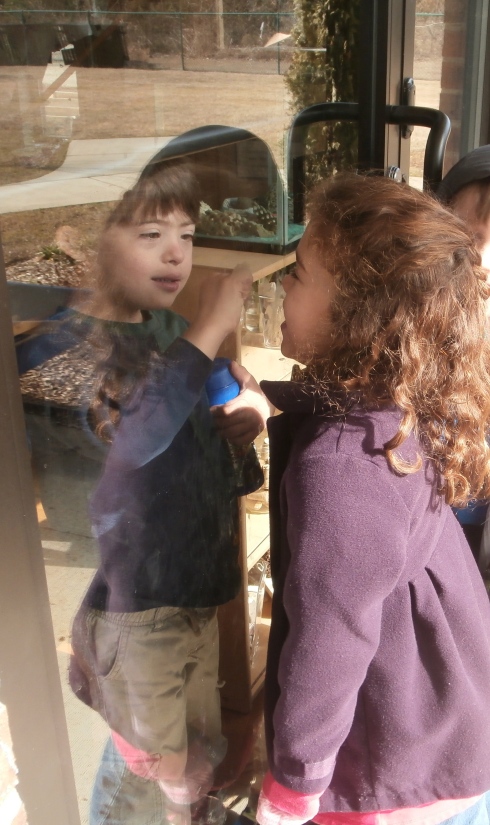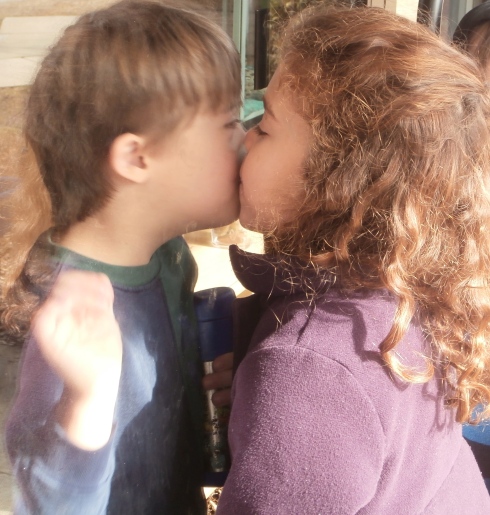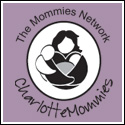By Vicki Vila
As parents, sometimes we want a peek into the future.
What kind of job will our children have? Who will they pick as their partner? Will they ever stop leaving piles of clothes in a trail on the floor?
We use our own life experiences to guide our children as best we can. But if you have a son with Down syndrome like I do yet never met anyone with that genetic makeup while growing up, the future can seem more mysterious.
People with Down syndrome are living longer, healthier lives than ever before, with more opportunities to be included in the wider community and pursue higher education. But there also exists a long and sad history during which parents were counseled to put their babies in institutions, and most did, so generations of people missed out on getting to know them.
At the same time, new prenatal blood tests have made it easier to predict early in a pregnancy if a fetus may have Down syndrome, though an invasive test must still confirm the diagnosis. Some worry these tests will push the abortion rates higher for Down syndrome pregnancies, though data on abortion does not yet include those tests.
With these facts in mind, I was quite happy for the chance to see people with Down syndrome featured on their own reality show – the A&E series “Born This Way.”
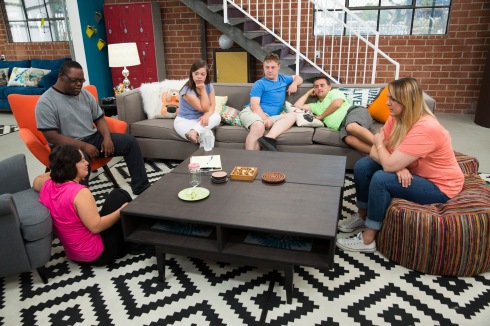
Left to right: Elena, John, Cristina, Steven & Sean at the community center Leaps n Boundz with a support worker. (Photo Credit: Adam Taylor, A&E Network)
The show is set in Los Angeles and has aired on Tuesday evenings at 10 p.m. EST for the past six weeks. It finishes today, but has been renewed for a second season, which the network said indicates a broad appeal.
I’ve watched with a friend who also has a young son with Down syndrome and we enjoy seeing the seven young adults interact with each other and figure out their lives. Though I think most reality shows are exploitive and not worth watching, this is a very positive and likable show. It’s a project from Bunim/Murray Productions, which created the reality show format with the MTV franchise “The Real World.” This latest venture, though, is free of backstabbing and alcohol-fueled revelations. The cast members really support each other and when an issue arises, they argue but work it out.
They are fun to watch and represent different archetypes. Megan, 22, is very ambitious and thinks highly of herself. She is a public speaker and is starting her own clothing business called Megology. “Don’t limit this diva because I’m right here,” she says. Cristina, 25, is socially mature and has a longtime boyfriend she would like to marry. Sean, 21, is pegged as a ladies’ man on an eternal quest for a girlfriend. Rachel, 32, is a likeable everywoman with a job who loves R-rated movies and American Idol. John, 28, an aspiring rap artist, is the comedian of the group. When he cracked an egg on his forehead during cooking class, I saw glimmers of my son.
Elena, 28, is highly emotional and doesn’t like it when people mention Down syndrome. “I don’t know why God gave me that,” she says. I worried over whether producers were filming in such a way to highlight her anxiety. Elena was born in Japan and her mother said it brought great shame to the family and took her 20 years to accept her daughter’s diagnosis, so it is possible Elena has internalized that. Steven, 24, works at a baseball stadium and dispenses sage advice. When one cast member said Elena needed to be nicer and control her emotional outbursts, Steven said, “You want her to be perfect. I think the best thing for Elena is to be who she is, rather than something that she’s not.”
“Born This Way” has been hailed as groundbreaking in some corners, and criticized in others for portraying an overly rosy look at life for adults with Down syndrome.
David Perry, a critic of how disability is portrayed in the media and a writer I respect, says the show is “basically fine” but doesn’t go far enough to promote inclusion. Personally, I don’t think it’s going to change the world – that’s a long-term project – but it is a leap in the right direction, because the world by and large doesn’t have high expectations for those with Down syndrome and I think most people don’t realize how interesting and varied they can be.
This is not the first time Down syndrome has been on TV. But it’s the first time I can recall a full cast of people with intellectual disabilities on an American show. In 2009, an online show in the U.K. called “The Specials” won critical acclaim for its portrayal of a group of young adults with intellectual disabilities. In the United States, my generation grew up with “Life Goes On,” about a boy with Down syndrome and his family, starring Chris Burke. Today’s television landscape has a variety of talented adult actors with Down syndrome, including Lauren Potter of “Glee,” Jamie Brewer of “American Horror Story” and Luke Zimmerman from “The Secret Life of the American Teenager.”
One common criticism I’ve read about “Born This Way” is that it focuses too much on interviews with the parents, and this bothered me at first too. Beth Haller, a disability scholar who is a journalism professor and the director of the Communication Management master’s program at Towson University in Maryland, said she thinks the show is “an important and helpful addition to representations of people with disabilities on TV.” But she thinks the parents disrupt the narrative.
In “The Specials,” of which she is a big fan and wrote the show’s Wikipedia entry at its request, she said that parents, family members or personal attendants have very little screen time. “It felt more inclusive because one of the adults from the group home narrated each episode,” she said, and there was less of the sitting before the camera to reflect on things that happened.
“Nothing against the parents,” she said, “they all seem very nice, and they obviously care about their adult children.” But she would like to see the show more focused on the adults and their activities. “To me, when the parents have so much screen time, it shifts the focus of the show to be for parents of disabled people, rather than a more general audience.” With that said, she added, “I still appreciate the show for focusing on the lives of people with intellectual disabilities and will definitely keep watching.”
My friend and I have definitely enjoyed having this peek at some real people with Down syndrome on “Born This Way,” and I guess I’ve been less bothered by the parent interviews as time has passed. In the first episode, cast members gather with their families for dinner on a pretty outdoor patio. People banter comfortably and pass around delicious-looking platters.
My friend commented: “It’s just encouraging to see them walking around, talking with friends, having a good time at dinner, not throwing their food.” Or licking each other’s elbows, I interjected, referencing something my 7-year-old son thinks is hilarious to do to his sisters.
On a more serious note, watching adults with Down syndrome laugh and talk with their friends can seem like a big deal to some.
Parents of young kids have told me the show gives them hope they’ll be able to have a meaningful conversation with their child someday. You see, people with Trisomy 21 – the medical name for Down syndrome – are almost always delayed when it comes to communicating. As with many things, it’s a spectrum, with some children becoming quite chatty while others speak in short phrases or use a communication device or sign language, and these skills are constantly evolving.
Stacey Calcano, of New York City, has a preschooler with Down syndrome and said the cast should not be held up as the best way to be an adult with Down syndrome. She brought up a point that I’ve heard other parents echo and I think is valid. “It’s really bothering me that our community is presenting itself in a way that we need “proof” of what our kids “may” be able to do for peace of mind,” she said. “If our children grow up without the same abilities as the adults on the show, does that make them less valuable as human beings? No!”
I ask myself if I am falling into this trap, and maybe I am. I DO want my son to be well spoken, but I also think he’s already there at age 7. I enjoy him very much and think he’s hilarious, but the truth is people who don’t know him may have trouble understanding him. I’m okay with that; we’re working on it.
There is a broader truth at play, and I think it’s double-sided. On one side, the show is an indicator to a wider audience of how much has changed since routine institutionalization. On the other hand, I think people with Down syndrome will always struggle with some things, so it isn’t that the cast members have better skills than others, just different ones.
Megan still needs to learn to do laundry and grocery shopping. John’s mother says she doesn’t think he could ever live independently and is greatly relieved when her daughters reassure her he can live with one of them if need be. Some of the cast did not know how to ride a two-wheeled bike until they went to a camp to learn during filming. (Bike riding is also harder for people with Down syndrome because of low muscle tone and balance issues. I give credit to the show for having Steven explain this when talking about the camp.) Rachel, one of my favorite characters, does her own shopping and laundry and has a job in an office mailroom, but because of sensory issues has a fear of loud places and can’t handle crowds.

Rachel, Sean, Cristina and Steven. (Photo Credit: Adam Taylor, A&E Network)
So what do adults with Down syndrome themselves think of the show?
I decided to ask some. I spoke via phone to Alex Bender, 22, who attends the TAP program at the University of Cincinnati for people with intellectual disabilities and is studying photography. She heard about the show from her Mom. She said Megan is her favorite cast member. “She’s awesome,” Ms. Bender said. Her mother, Gary Hughes Bender, who wrote a book about raising Alex, told me that Alex did not seem to like the parts of the show where cast members were all together at a community center because her life is more inclusive.
When I asked the younger Ms. Bender if there was anything she didn’t like about the show, she quickly replied: “I told my Mom I loved it. I didn’t like her keeping me up so late to watch it, but I loved the show.” She did see a few parallels between her life and Megan’s. Like Megan, Ms. Bender is close with her Mom, who is also a single mother. Ms. Bender said she loves her school and sees her future in Cincinnati. “But then there is my Mom,” she said jovially, “she wants me in her life.” Her mom lives in San Francisco.
Rion Holcombe, 22, attends the ClemsonLife program for people with intellectual disabilities and has a girlfriend. He became an Internet sensation in 2014 when a video of him opening his acceptance letter to the competitive program went viral. I did not speak with him directly, but his Mom told me he watched one episode of “Born This Way” and found it very entertaining. She said he gave her permission to pass along his thoughts. “He identified with the guys,” said Susan Holcombe, “guys he would definitely be friends with, but his favorite is John. Quite a character that John!”
She said they discussed some of the things in the show, like what would happen when she and his dad get too old to care for him. “One thing I know is that he cannot live on his own,” she said, “but he adapted quickly and happily to dorm life with his three roommates. He walks to class (a mile) and crosses traffic to walk to work three days a week, and takes a bus to the grocery store to shop. So he agreed that living in a smaller group home would be a possibility.” She said her son is really level headed with strong values. Whereas she finds the show insightful, to him it’s just entertaining. “He would rather be watching the Teen Disney shows,” she said.
I also spoke with the family of Jacob Gehringer, 20, a self-advocate from the Omaha area who carries around his own bio sheet to hand to community leaders. His mother, Denise Gehringer, told me that Jacob was fully included in both “place and curriculum” in high school and now is in his second year of vocational training in his school district.
Ms. Gehringer told me that her son has said “Thank you!” out loud many times when the cast makes comments on “Born This Way.” He especially gave his “Thank you!” she said, when two of the guys – I think it was Steven and Sean — were having drinks at the bar and talking about dating. Jacob was in agreement when Sean got advice from his friend to stop pursuing a cast member that already had a boyfriend. For this article, Ms. Gehringer asked her son directly about the show and forwarded me the questions and answers.
Q: Would you like to hang out with the gang on “Born This Way?”
A: I don’t know. I don’t know if we like the same things.
Q: What did you think when the gal got upset when she heard the words Down syndrome?
A: It hurts her feelings. I would not say it to her.
Follow Up Q: Does it hurt your feelings when you hear Down syndrome?
A: NO! Why would it hurt my feelings? I’m not the same feelings as her. (Under his breath) Stupid question.
Q: What do you think when the guys were talking about dating?
A: (Very reluctant to talk about this with his mom). I don’t know. That guy should respect boundaries.
Q: I thought I heard you commenting about the one guy getting to live in his own place. What did you think about that?
A: I want a house with a yard for my dog.
Q: Do you want to watch more of this show?
A: No. “Agent Carter” is coming back on.
“So there you have it,” said Ms. Gehringer. “Apparently he was much more unimpressed than I thought.”
I love the variety of responses I got, and I like that some other families whose young adults have Down syndrome I reached out to said their sons or daughters were too busy to watch the show. Others said their children weren’t aware of it.
One thing that struck me while reading parents’ opinions about the show on social media is those who said the cast is not representative of the average adult with Down syndrome because they are fairly independent with strong verbal skills.
Is there an “average” adult with Down syndrome though? I decided to ask someone from the National Down Syndrome Congress because they meet people from all over the country. Sue Joe, the communication director, said in an email: “There continues to be such a focus on what people with Down syndrome “can’t do” or “will never be able to do”, that we’ve found “Born This Way” to be very exciting in presenting what people with Down syndrome can do!”
“The reality is,” she said, “we meet people just like the cast at our convention each year. And we also meet individuals who use assistive technology to communicate or who need a caregiver nearby to get through each day. They all bring unique qualities into the world.” On that note, Sean’s mom, Sandra Assimotos McElwee, told me in an email that when the producers asked for feedback, she told them they should consider adding someone to the cast who is nonverbal.
Among people with Down syndrome, the level of independence isn’t the only thing that varies.
Ms. McElwee, who has written books and keeps a blog about her and her son’s experiences, told me that she and her husband always knew that Sean’s future depended on the supports they could access.
“I know now,” she said, “that we are fortunate to live in a state that provides those supports and services. I hope now as parents see what is possible, they can lobby their own states and school systems to support their children as well.”
She sent me a jaw-dropping list of programs that are entitlements in California for people with disabilities, which means there is no waiting list for them. Her list included things like respite, behavioral therapy and potty training for children, as well as adult support and independent living services. She said years ago, some “mothers from hell” who lived in Sacramento paved the way for this by riding the elevator every day with legislators at the Capitol and told them about their kids and what they needed in services. (Take notes people. Find your state legislators here.)
Compare that to North Carolina, where I live. Melinda Plue, the director of advocacy and chapter development for The Arc of North Carolina, said the state has “somewhere between ten and twelve THOUSAND people on a waiting list for what we call Innovations waiver services.” Waiver services are the menu of supports that make it possible for people with intellectual disabilities to work on specific goals within their home or community.
She said “the people highlighted in this show either have no need for these services, or it seems that they have already them in place.”
Ms. Plue has two children and also provides support to her brother-in-law with an intellectual disability (not Down syndrome) who lives next door, independently but with some of the aforementioned services. She has watched all the episodes to date and says her brother is not a fan of the whole “get away from family” thing that she feels the show promotes. “He prefers us handling lots of his business,” she said. “But those dreams — college, girlfriends, etc., those are his too.”
It is wonderful, she said, “to see that people with intellectual disabilities (and, for the purposes of this show, people who have Down syndrome) can and do lead very independent lives when the support system is in place to make this happen. It’s great that parents are being portrayed as dream-makers and are finding success for their children.”
She would want to be careful that the show does not discourage other parents of children with disabilities. “There are many people watching the show who have limited financial means and much more challenging needs to support (physically, mentally, emotionally, behaviorally) and whose children have the same potential as the people on this show.”
“There are individuals with disabilities who find the world much less accommodating than these families in Los Angeles, either because their communities haven’t fully embraced their needs, or because the support systems are so different state to state.”
“Good or bad,” Ms. Plue said, “this show is bringing to the surface many issues for which organizations like mine work to change each day.”
Personally, I love all of the conversations this show has started. Ms. McElwee said she “knew the show would introduce the world to seven people with Down syndrome” and had “high hopes that it would be a game-changer for people with all disabilities,” but she didn’t know how exactly that would play out.
Some positive changes she’s learned of include a grocery store chain using a courtesy clerk with Down syndrome for an employee training video and a man who decided to hire two adults with disabilities after seeing Sean’s interview on the show. She has also been contacted by several general educators for advice on how to approach their school districts about including students with disabilities in their classrooms.
“Parents of children both with and without Down syndrome are watching the show together and having important discussions about acceptance, abortion, and making friends with people who are different than themselves,” Ms. McElwee said.
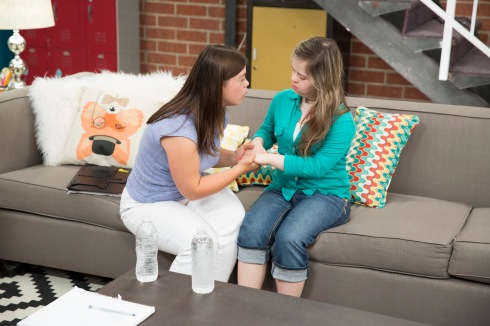
Cristina and Megan. (Photo Credit: Adam Taylor, A&E Network)
“There’s a multitude of people, previously ignorant, who now are enlightened,” she said. “Television is the most powerful medium.”
I asked if she would be doing anything differently now regarding how she advises Sean because of his involvement in the show.
“The most powerful thing that has come from Sean watching himself on TV is his own awareness,” she said. “We told him that a “ladies man” meant a player. But he insisted it meant that he really liked ladies. He now knows we knew what we were talking about. We believe that learning by mistakes are the most powerful and long-lasting lessons, and we allow Sean to make mistakes, instead of saving him all of the time.”
There has been some pushback about how forward Sean is in his pursuit of a girlfriend. In episode four, he keeps telling Megan he likes her a lot even though she has a boyfriend, and then when he meets a young woman with Down syndrome at a convention, one of the first questions he asks is “Do you have a boyfriend?” This made me feel uncomfortable for that woman.
Ms. Plue of The Arc said she found it unsettling that Sean’s behavior toward women “is seen as almost cute.” (To be fair, Sean’s father does have a talk with him about how to treat young women he’d like to date and Ms. McElwee said they taught Sean to ask about boyfriends so he wouldn’t pursue someone already taken.) “If it wouldn’t be appropriate for a peer without a disability to say in public,” Ms. Plue said, “I believe there should be an active effort to redirect the behavior.”
As for Sean, I asked him what he liked about being on the show. “People know who I am now and they are very friendly,” he said. “It’s very fun and I like it when people recognize me.”
Had he gained any insights?
“Yes,” he said. “I don’t want to like other boys’ girlfriends anymore. But I still need a girlfriend.”
In the meantime, he’ll have some good friends by his side. His mom said the friendships depicted on the show are genuine. I say bravo to the cast of “Born This Way” for transcending reality show tropes. Their friendship is the most enjoyable thing about the show and I’m excited to watch tonight.
You can watch past episodes at the network’s website.
